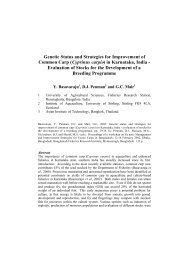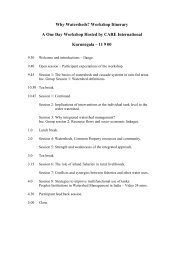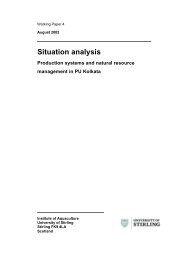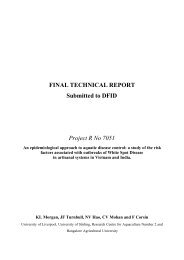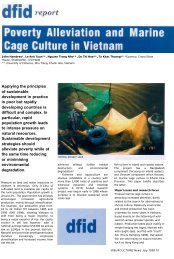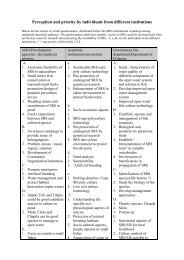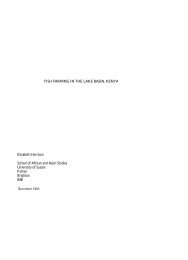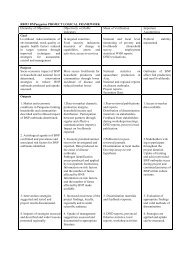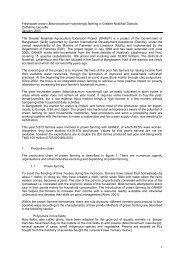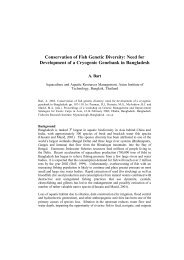Epizootic Ulcerative Syndrome (EUS) Technical Handbook
Epizootic Ulcerative Syndrome (EUS) Technical Handbook
Epizootic Ulcerative Syndrome (EUS) Technical Handbook
Create successful ePaper yourself
Turn your PDF publications into a flip-book with our unique Google optimized e-Paper software.
DiagnosisDiseased striped snakeheads, with moderately advanced lesions, placed inimproved water quality conditions often recover. Similarly, lesions on estuarinefish such as mullet appear to heal quickly when fish move into brackish ormarine environments. Healing ulcers are characterised by a conspicuousdark colour caused by increased numbers of melanophores.HistopathologyA general description of the typical histopathological developments that occurin <strong>EUS</strong>-diseased fish is given here with reference to some observations inparticular species.The early skin lesions of some samples have been observed and found to beprincipally areas of epithelial necrosis with surrounding oedema,haemorrhaging of the underlying dermis and some inflammatory cellinfiltration. It has not been possible to confirm fungal involvement in most ofthese early samples but a few have harboured a small number of hyphae. Thepresence of fungal hyphae was demonstrated in the epidermis of some earlystages of infected fish from India (Viswanath et al., 1997). Similarly Robertset al. (1989) were able to study early lesions during an <strong>EUS</strong> outbreak in acaptive population of Indian major carp. They observed an acute necrotisingmyopathy, more severe than is usually seen in wild fishes, spread over a widearea below the active skin lesion. The epidermis at the margins of the ulceritself was degenerate and thickened, and contained only a very small numberof fungal hyphae enclosed within an epithelioid capsule. The blood vessels ofthe dermis were very hyperaemic and some had a collar of lymphoid ormyeloid cells which might be associated with virus infection although noviral inclusion bodies were detected.Subsequent pathological developments in all infected fish species involvesignificant degenerative changes in skin and muscle tissue with minimaldisruption of internal organs.In advanced lesions there is massive necrotising granulomatous mycosis ofthe underlying muscle fibres, involving the distinctive branching aseptate,invasive fungal mycelium. Large numbers of bacteria may be present on thesurface of some advanced lesions. With advancing age of the lesion, fungalcells become progressively enveloped by thick sheaths of host epithelioidcells, and some areas may show evidence of myophagia and healing. In someadvanced lesions, fungal hyphae can be seen invading the abdominal viscera,which would almost certainly be the ultimate cause of death. A large numberof mycotic granulomas have been demonstrated in the kidney, liver anddigestive tract of several fishes including spiny eels, Cirrhinus mrigal, Colisalalia, Channa sp., Puntius sp., Esomus sp., Mugil sp., Valamugil sp., Therapon sp.,Glossogobius sp. and Sillago sp. (Chinabut, 1990; Ahmed and Hoque, 1998;Wada et al., 1994; Viswanath et al., 1998). Wada et al. (1994) also found mycoticgranumlomas in the abdominal adipose tissue, pancreas, gonad, spleen,central nervous system and heart of dwarf gourami; and Vishwanath et al.(1998) further demonstrated fungus penetrating the oesophagus and spinalcord of mullet and intermuscular bones of Puntius.31




